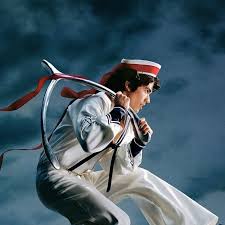Straight Outta Compton review
The first thing I feel is necessary to include in this review is a warning: Straight Outta Compton is a brutally honest portrayal of gang life, and I believe most viewers would have a hard time not being shaken.
Aside from its shock factor, Straight Outta Compton is well worth a watch and is the highest grossing music biopic ever for a reason. It details the rise to fame of rappers Eric “Eazy E” Wright, Andre “Dr. Dre” Young and O’Shea “Ice Cube” Jackson, the leaders of late ‘80s and early ’90s rap group N.W.A. The group is largely credited with the popularization of “gangsta rap.”
Just like N.W.A, the movie does not hold back in providing a clear view of life in 1980s Compton and the very real struggles of growing up in America’s low income neighborhoods. From the beginning scene, in which the Los Angeles Police Department uses a battering ram to break through the wall of a house where Eazy E partakes in a nearly-violent drug deal, Straight Outta Compton allows the audience to view life from the perspective of those born into “gang culture.”
The film is directed by Felix Gary Gray, who is known for movies like Friday, Set it Off and The Negotiator, but he spent a large portion of his career directing music videos. In fact, he directed a few of Ice Cube and Dr. Dre’s music videos early in their careers, so he is no stranger to the ‘90s rap community. Because of his experience directing music videos, he was able to portray the lives of N.W.A more accurately than perhaps any other director.
The main characters in the film are played by a young, relatively unknown cast, but I believe they were able to fulfill such complex characters. In fact, Ice Cube’s character is played by his son, O’Shea Jackson, Jr. However, the role was not simply handed out to him. He went through a two-year audition process to finally earn it.
The movie centers on the idea that N.W.A gave a voice to an extremely underrepresented portion of the country. People in Compton during the 1980s lived in the middle of violent gang culture, but for a long time these problems remained out of the public’s eye.
One scene in particular comes to mind, in which a few students on the way to school tease a random car driver next to their bus. The car driver proceeds to pull the bus over, walk on and threaten the students with a pistol. The students and the bus driver appear unfazed by an act that would be unimaginable at Westlake.
Reviewing this movie, I would be remiss in not including the conflict between the main characters and the police. Not only was this conflict a major part in the lives of the members of N.W.A, but in fact it remains a problem in American society today. From freedom of speech issues that arise from denouncing corrupt law enforcement practices to riots in the name of civil rights, issues between African Americans and the police are just as topical now as they were at the height of N.W.A’s fame. If the 1980s LAPD is portrayed accurately in the movie, I find it hard to believe that anyone would deny that African Americans in Compton were, and perhaps still are, treated with gross injustice.
As the movie is about two and a half hours long, there are definitely some slow parts in the middle, but in all I would strongly recommend watching Straight Outta Compton. It certainly offers an alternative perspective on life that I believe is eye-opening to most viewers and is enjoyable even for people who are not fans of rap music.





